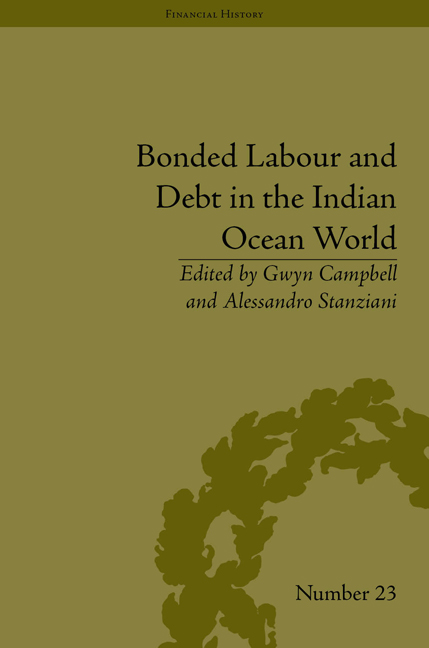Book contents
- Frontmatter
- Contents
- Acknowledgements
- List of Contributors
- Introduction
- 1 Debt and the Coercion of Labour in the Islamic Legal Tradition
- 2 Debt, Pawnship and Slavery in Nineteenth-Century East Africa
- 3 Debt and Slavery in Imperial Madagascar, 1790–1861
- 4 Credit and Debt in the Lives of Freed Slaves at the Cape of Good Hope: The Case of Arnoldus Koevoet, 1697–1735
- 5 Debt, Labour and Bondage: English Servants versus Indentured Immigrants in Mauritius, from the Late Eighteenth to Early Twentieth Century
- 6 Ransom, Escape and Debt Repayment in the Sulu Zone, 1750–1898
- 7 Debt and Slavery among Arabian Gulf Pearl Divers
- 8 The Political Economy of Debt Bondage in Contemporary South India
- 9 The Name of the Slave and the Quality of the Debt: When Slaves Are Not Debtors and Debtors Are Not Slaves in the Family Narrative of a Filipina Comfort Woman
- 10 Two Bonded Labour Emigration Patterns in Mid-Nineteenth-Century Southern China: The Coolie Trade and Emigration to Southeast Asia
- 11 Debt Slaves in Old Korea
- 12 The Debt-Servitude of Prostitutes in Japan during the Edo Period, 1600–1868
- Notes
- Index
3 - Debt and Slavery in Imperial Madagascar, 1790–1861
- Frontmatter
- Contents
- Acknowledgements
- List of Contributors
- Introduction
- 1 Debt and the Coercion of Labour in the Islamic Legal Tradition
- 2 Debt, Pawnship and Slavery in Nineteenth-Century East Africa
- 3 Debt and Slavery in Imperial Madagascar, 1790–1861
- 4 Credit and Debt in the Lives of Freed Slaves at the Cape of Good Hope: The Case of Arnoldus Koevoet, 1697–1735
- 5 Debt, Labour and Bondage: English Servants versus Indentured Immigrants in Mauritius, from the Late Eighteenth to Early Twentieth Century
- 6 Ransom, Escape and Debt Repayment in the Sulu Zone, 1750–1898
- 7 Debt and Slavery among Arabian Gulf Pearl Divers
- 8 The Political Economy of Debt Bondage in Contemporary South India
- 9 The Name of the Slave and the Quality of the Debt: When Slaves Are Not Debtors and Debtors Are Not Slaves in the Family Narrative of a Filipina Comfort Woman
- 10 Two Bonded Labour Emigration Patterns in Mid-Nineteenth-Century Southern China: The Coolie Trade and Emigration to Southeast Asia
- 11 Debt Slaves in Old Korea
- 12 The Debt-Servitude of Prostitutes in Japan during the Edo Period, 1600–1868
- Notes
- Index
Summary
Introduction
The relationship between indebtedness and bondage is complex. Debt – social, political and economic – is widespread in all societies, plunging the debtor into a position of obligation towards the creditor concomitant with his or her degree of indebtedness. The rules governing these obligations and their relationship to the debt may be oral rather than written, but when formally witnessed and agreed to, they have the sanction of customary law, even where this differs from statutory law. This was the case in Imerina, in central highland Madagascar, where regulations governing debt became codified in the imperial Merina era (c. 1785–1895). However, the creditor–debtor relationship became increasingly more complex as a result of the adoption of autarky from the mid-1820s, and the policies intrinsic to it, such as military expansionism and the growth of fanompoana – unremunerated forced labour for the state. This contribution first sets the historical context, then discusses the causes and consequences of the main changes in the creditor–debtor relationship in Imperial Madagascar, and subsequently compares and contrasts debt servitude to other forms of bondage.
Background
In the 1790s, Andrianampoinimerina (r. c. 1787–1810) emerged triumphant from a period of internecine wars to claim sovereignty over the four provinces of Ankova (the core region of the area that in expanded form became known as Imerina).
- Type
- Chapter
- Information
- Bonded Labour and Debt in the Indian Ocean World , pp. 45 - 56Publisher: Pickering & ChattoFirst published in: 2014

